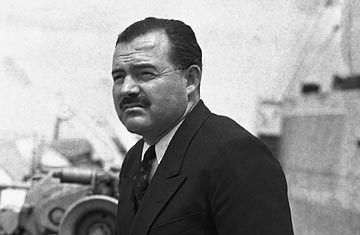
Author Ernest Hemingway in 1937
Half history lesson, half celebrity exposé, author Alix Strauss's new book, Death Becomes Them: Unearthing the Suicides of the Brilliant, the Famous, and the Notorious, is a pop-culture take on one of society's most painful topics. Focusing on 20 famous figures who took their own lives, Death Becomes Them provides the backstories behind the tragic and manic last days of icons ranging from Kurt Cobain to Vincent van Gogh to Virginia Woolf. Equally sad and shocking, Strauss's profiles help fans and cult followers better understand how these brilliant, tortured souls crossed the line from depression to self-destruction. TIME talked to Strauss about what it was like to report on death and the surprises she uncovered.
Why do you think there is such a morbid fascination with certain suicides, sometimes even centuries after they took place?
Because suicides are like riddles with the answers left out. So people are constantly struggling to find that "aha" moment — the event or encounter that pushed someone over the edge from sadness to suicide. There is this need to know what made them do it — and, perhaps, how it could have been prevented.
And Death Becomes Them is about filling in these gaps?
Exactly. Each of these characters left not only unanswered questions but unrealized talent and unknown potential as well. We'll never know what else van Gogh might have painted. Or how another Diane Arbus portrait might have turned out. Or how a later Hemingway novel might have read.
Each story reads like its own mini–mystery novel. They're incredibly fact-filled.
We didn't just look at the events leading up to the suicides but at the actual pathologies of how each figure chose to end their life. So the devil here is truly in the details. Who knew that Anne Sexton had several glasses of vodka and put on her mother's fur before gassing herself? Or that Abbie Hoffman was watching his favorite film, The Godfather, as he swallowed a fatal dose of whiskey and barbiturates? Or that when the police departed — and she was finally left alone with her dead husband's corpse — Courtney Love dipped her hands in Kurt Cobain's blood before eerily washing a piece of his blown-out skull?
Many of your subjects were also investigated as murder cases.
There are a lot of conspiracy theorists who insist some of these people were actually killed, and we address those questions. Some say musician Elliott Smith could not possibly have stabbed himself through the chest without help. And everyone from authors to filmmakers have long believed that Courtney Love was involved in Kurt Cobain's death. Ultimately, we left it to the professionals. If the police report ruled it a suicide, we ruled it a suicide.
How was it researching and writing the book? Did all that death impact your life?
It felt like I was in this swirl of morbidity for six months. But the work was as fascinating as it was depressing. All of that depression, and the waste of life, made me want to make the most of my own.
Were any of these stories almost too painful to report?
As a Jew, [I found that] Hitler was very difficult to write about. Every other story here is a tribute and a celebration of someone's life, so we struggled with whether it was appropriate to include him. Ultimately we agreed Hitler could not be overlooked.
Each story is obviously very different, but were you able to identify any unexpected patterns?
There were actually quite a few. None of the women, for instance, shot themselves, though many of the men did. Poisoning was favored by people in positions of power, such as Hitler. Most of the actors chose to be cremated. And there was also the unusual discovery that authors who write in the first person are far more at risk for suicide.
Many of your subjects had drug problems.
Not just drug problems but full-blown addictions. Kurt Cobain was a daily heroin user. Michael Hutchence's body was found surrounded by narcotics. Anne Sexton was a serious alcoholic. These were not people able to make the best decisions for themselves.
There is renewed interest right now in English mathematician Alan Turing, a World War II hero who killed himself in 1954 rather than face criminal charges for homosexuality. British Prime Minister Gordon Brown recently issued an apology for the "appalling treatment" Turing received.
Turing was clearly someone who was way ahead of his time and deeply misunderstood by the society in which he lived. His honesty about his life and loves would be taken for granted today, but more than 50 years ago it led directly to his death. Suicide is still a very serious problem for gays and lesbians, and Brown's apology could certainly help people struggling today.
There is a lot of technical information in the book. Are you at all worried that it could be used as a how-to guide?
There is always that concern with any book that is dark and deep as well as informative. I want people to be engaged with the book — but certainly not that engaged.
